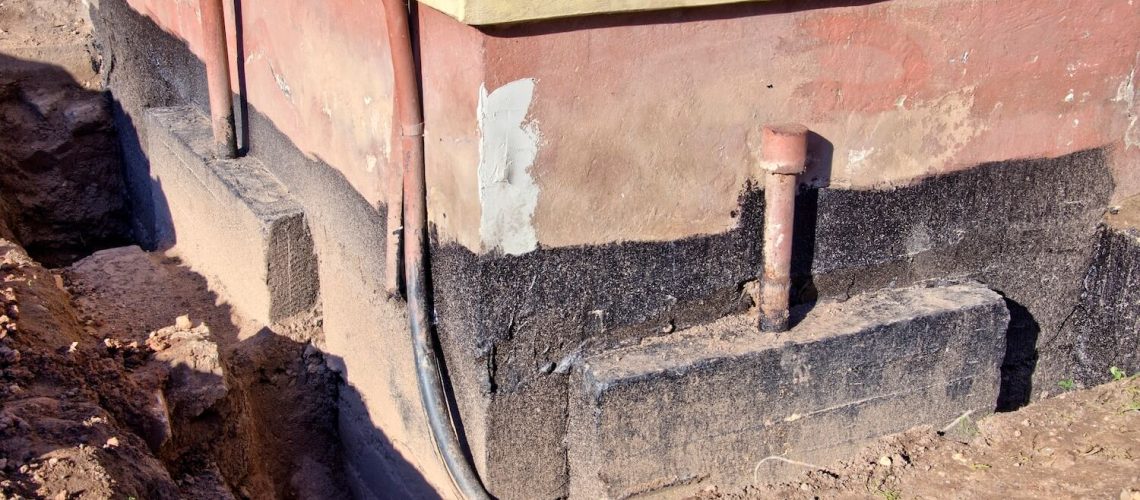When embarking on the journey of constructing or maintaining a building, the foundation is undeniably the most crucial element. Among the various components that contribute to a robust foundation, footer stabilization plays a vital role. This comprehensive guide explores the importance of footer stabilization, various methods of stabilization, and the critical steps involved in hiring a contractor for foundation repair.
Understanding Footer Stabilization
Footers, or footings, are structural elements that distribute the weight of a building’s foundation to the soil beneath. They are typically made from concrete and serve as the base for the foundation walls. The primary purpose of footers is to provide stability and support, ensuring that the building remains level and secure over time. Footer stabilization refers to the reinforcement and support mechanisms used to enhance the stability of these footers, preventing issues such as settlement, shifting, and structural failure.
The Importance of Footer Stabilization
1. Load Distribution and Structural Integrity
Footers are designed to evenly distribute the weight of the building across the foundation. Proper stabilization ensures that this distribution remains uniform, preventing uneven settlement and structural issues like wall cracks and floor slopes. Without effective stabilization, the load distribution can become compromised, leading to significant structural problems.
2. Prevention of Settlement
Soil settlement occurs when the soil beneath the foundation compresses or shifts due to factors such as moisture changes, poor compaction, or increased load-bearing requirements. This can lead to foundation movement and structural damage. Footer stabilization techniques help address these issues by providing additional support and anchoring, reducing the risk of settlement.
3. Mitigation of Soil Variability
Soil conditions vary significantly across different regions. Some soils may have low load-bearing capacities or be prone to expansion and contraction. Footer stabilization methods can be customized to address these soil conditions, ensuring that the foundation remains stable despite varying soil characteristics.
4. Avoidance of Structural Damage
Unstable footers can lead to a range of structural problems, including foundation cracks, wall bowing, and misaligned doors and windows. Proper footer stabilization helps prevent these issues, maintaining the building’s structural integrity and reducing the need for costly repairs.
4. Long-Term Durability
Investing in footer stabilization contributes to the long-term durability of the foundation. By addressing potential issues early and implementing effective stabilization methods, homeowners and builders can ensure that the foundation remains solid and secure for years to come.
Methods of Footer Stabilization
Footer stabilization involves various techniques, each suited to different conditions and requirements. Here’s an in-depth look at common methods:
1. Underpinning
Underpinning is a technique used to extend the depth or breadth of existing footers to reach more stable soil layers. This method is often employed when the original footers are insufficient or when there are changes in load-bearing requirements. Common underpinning methods include:
- Pier and Beam Underpinning: This involves installing piers or columns beneath the existing footers to transfer the load to deeper, more stable soil layers. The beams connect the piers to the footers, providing additional support.
- Mini-Pile Underpinning: Mini-piles are small-diameter piles driven deep into the ground to support the footers. This method is suitable for areas with limited access or where traditional underpinning methods are not feasible.
2. Piling
Piling involves installing long, slender columns (piles) deep into the ground to transfer the building’s load to more stable soil or rock layers. There are several types of piles:
3. Helical Piers
Helical piers are steel rods with helical plates that are screwed into the ground to provide support. They are versatile and can be used for both new constructions and repairs. Key benefits of helical piers include:
- Quick Installation: Helical piers can be installed relatively quickly compared to other methods, minimizing disruption to the site.
- Minimal Soil Disturbance: The installation process causes minimal disturbance to the surrounding soil, making it suitable for areas with limited access.
- Adjustable Load Capacity: Helical piers can be adjusted to support varying load capacities, making them adaptable to different foundation needs.
4. Grouting
Grouting involves injecting a cement-based or polyurethane grout into the soil beneath the footers to improve its load-bearing capacity and fill voids. There are several types of grouting methods:
5. Important Foundation Reinforcement
In some cases, additional reinforcement may be added to existing footers to enhance stability. This can include:
- Additional Concrete: Adding more concrete to the footers increases their strength and load-bearing capacity.
- Steel Reinforcements: Incorporating steel bars or mesh into the footers provides additional support and helps prevent cracking.
- Additional Footings: Adding extra footings can distribute the load more evenly and provide additional support to the foundation.
The Impact of Proper Footer Stabilization
Proper footer stabilization has a profound impact on the overall stability and longevity of a building. Here’s how it benefits homeowners and builders:
- Enhanced Structural Integrity: Stabilized footers ensure that the building’s load is evenly distributed, reducing the risk of structural issues and maintaining overall building integrity. This contributes to a safer and more durable structure.
- Increased Property Value: A well-maintained foundation enhances property value. Potential buyers are more likely to invest in a property with a stable foundation, which can increase its market value and appeal.
- Reduced Maintenance Costs: Stabilizing footers helps prevent issues like cracks, uneven floors, and shifting walls. This reduces the need for extensive repairs and ongoing maintenance, leading to cost savings over time.
- Improved Safety: A stable foundation is crucial for safety. Proper footer stabilization reduces the risk of structural failures that could pose safety hazards, ensuring the well-being of occupants.
- Long-Term Peace of Mind: Investing in footer stabilization provides long-term peace of mind, knowing that the foundation is secure and less likely to experience significant issues in the future.
Signs That Footer Stabilization May Be Needed
Recognizing the signs that footer stabilization may be necessary is crucial for addressing potential issues early. Common signs include:
- Cracks in Walls: Horizontal or diagonal cracks in walls, particularly near corners or windows, can indicate foundation problems. These cracks may be a sign of settling or shifting footers.
- Uneven Floors: Sloping or uneven floors can result from unstable footers. This can affect the overall comfort and safety of the building and may indicate underlying foundation issues.
- Doors and Windows Misalignment: Difficulty opening or closing doors and windows, or noticeable gaps around them, can be a sign of foundation movement due to unstable footers.
- Exterior Cracks: Cracks in the exterior of the building, such as in the foundation walls or brickwork, may indicate footer issues and require prompt attention.
- Water Drainage Problems: Poor drainage around the foundation can lead to water accumulation and soil erosion, affecting footer stability. Addressing drainage issues can help prevent footer problems.
How to Address Footer Stabilization Issues
If you notice signs of home footer issues, it’s essential to take the following steps:
- Consult a Professional: Engage a qualified structural engineer or foundation specialist to assess the condition of the footers. A professional evaluation will help determine the extent of the issues and recommend appropriate stabilization methods.
- Get a Foundation Inspection: A thorough foundation inspection will identify any issues with the footers and provide a detailed report on the condition of the foundation. This assessment is crucial for developing an effective stabilization plan.
- Implement Recommended Solutions: Based on the professional assessment, follow through with the recommended stabilization methods to address the identified issues. This may involve underpinning, piling, helical piers, grouting, or foundation reinforcement.
- Monitor and Maintain: Regularly monitor the condition of the foundation and footers to ensure that stabilization efforts remain effective. Address any new issues promptly to maintain foundation stability.
Hiring a Contractor for Foundation Repair
Selecting the right contractor for foundation repair is crucial for successful footer stabilization and long-term foundation health. Here’s a detailed guide on how to choose a qualified contractor:
1. Research and Recommendations
Start by researching local foundation repair contractors. Seek recommendations from friends, family, or real estate professionals who have experience with foundation repair. Online reviews and ratings can also provide valuable insights into contractor reputation and performance.
2. Check Qualifications and Experience
Ensure that the contractor is licensed, insured, and experienced in footer stabilization and foundation repair. Verify their credentials and look for a proven track record of successful projects. Experience in handling similar foundation issues is a critical factor.
3. Review References and Reviews
Ask the contractor for references from previous clients and contact them to inquire about their experience. Additionally, read online reviews and testimonials to gauge the contractor’s reliability, workmanship, and customer service.
4. Get Multiple Quotes
Obtain detailed quotes from several contractors to compare costs and services. Ensure that the quotes include all aspects of the stabilization process, including materials, labor, and any additional costs. Be cautious of quotes that seem unusually low, as they may indicate subpar quality or incomplete work.
5. Ask About Methods and Materials
Discuss the stabilization methods and materials the contractor plans to use. Ensure that they are using industry-standard practices and high-quality materials. The contractor should provide a clear explanation of why specific methods are recommended for your situation.
6. Evaluate Communication and Professionalism
Choose a contractor who communicates clearly and demonstrates professionalism. They should provide a detailed written estimate, answer your questions, and keep you informed throughout the project. Good communication is essential for a successful repair process.
7. Check for Warranties and Guarantees
Verify if the contractor offers warranties or guarantees on their work. A reputable contractor will stand by their work and offer protection in case issues arise after the repair is completed. Understand the terms and conditions of any warranties or guarantees provided.
8. Understand the Contract
Carefully review and understand the contract before signing. The contract should outline the scope of work, materials, timeline, payment schedule, and any warranties or guarantees. Ensure that all aspects of the project are covered and that you are comfortable with the terms.
Conclusion
Footer stabilization is a critical aspect of foundation construction and maintenance. Proper stabilization ensures even load distribution, prevents settlement, and maintains the overall structural integrity of the building. By investing in effective stabilization techniques and hiring a qualified contractor, homeowners and builders can safeguard the foundation and enhance the longevity and safety of their properties.
Whether you are building a new structure or addressing foundation issues in an existing property, prioritizing footer stabilization and working with experienced professionals will ensure that your foundation remains secure and stable for years to come.

